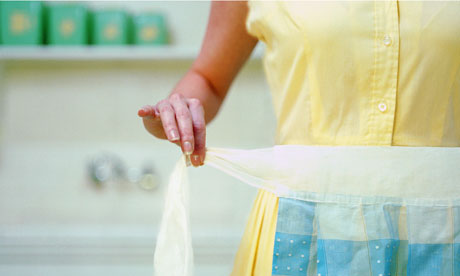
Of all the gadgets I associate with the kitchen of my childhood, it is the Kenwood Chef, sturdy and reliable, that I think of with the greatest affection. My mother owned one, and my stepmother, and for many years I thought that only when I owned one myself would I be fully adult. Only then, of course, I went and blew it. When I finally had enough spare cash, I turned into the worst kind of fashion victim and ordered a KitchenAid Artisan, a machine that might look delightfully cool and retro, but isn't half as efficient or easy to use. Plus – and this is something Nigella neglects to demonstrate on the telly – it weighs about eight tonnes. Stagger with it from cupboard to work surface and you've earned yourself the right to a cup of a tea and an iced bun before you've even started.
Thanks to the fact that I berate myself for this decision almost daily, I'd be lying if I told you my trip to see an exhibition about the history of Kenwood (it's at the wonderful Lightbox in Woking, the town where the mixer was first made) was an entirely happy one. As I toured the glass cabinets, my covetousness rose like the mercury on a hot Athens morning. Imagine Chaucer's Pardoner crossed with Victoria Beckham after a bad row with David, and you're about halfway there. If I hadn't been with a friend, I might have logged on to eBay bang in the middle of the gallery.
It wasn't only the latest machines, either. In the 70s, Kenwood manufactured the Superchef model in orange and brown plastic. Standing in front of a film of this beauty (it is so rare the curator could not turn up a model to put on display), I felt weak-kneed with desire. An orange Kenwood chef. Oh, man. It would look so good against my green tiles.
Kenneth Maynard Wood – his grandfather made Maynard's wine gums – founded his electrical company in 1936; the Kenwood Chef, a snazzy version of the A200 food mixer he developed in the late 40s, went on the market in 1950. It had a unique "planetary action", it cost £19 and it made him very rich indeed. Wood had a private plane called Kenwood, a yacht called Gay Jacqueline, and he spent 10 days a year at his very own hydro, Forest Mere, in Hampshire (Kenwood executives were also sent there twice a year; I picture them lying in bubbling water, dreaming of mincer attachments). At the Lightbox, you can see the gold Kenwood Chef charm he had made for his wife to hang around her neck. His delivery vans, meanwhile, had mixers attached to their roofs – jaunty sentinels that would call out to housewives even as they struggled home with their tartan trolleys.
I know Woking may not sound like a dream day out. You probably think my kitchen-nerd persona is getting beyond a joke. But this little exhibition is remarkable for the way it tells such a big story in so very few words. It's about the journey to the cheap food we now take so disastrously for granted (in the 50s, a third of a household's annual income was spent on food; a good mixer must have seemed like the ultimate investment). There's the way women's roles have changed (in 1961, men were exhorted to buy their wives a mixer for Christmas with the slogan: "The Chef does everything but cook – that's what wives are for!"). And it tells of the shift in tastes (Bircher's Cocktail for the Anaemic, a Kenwood recipe from the 40s which you will definitely not be making any time soon, is made of shin beef, crème de cacao and evaporated milk).
For me, though, what it mostly induced was guilt. Ken Wood succeeded for all sorts of reasons: his mixers had shire-horse motors and his salesmen were adept at pressing accessories (juicer, grinder, potato peeler) on new customers. But perhaps his product spoke, too, to a more sensible customer than me who knew they only needed one truly excellent machine.
Back at home, I wandered disconsolately around my kitchen, contemplating all the gadgets I hardly ever use. The pasta machine. The meat thermometer. The, er, egg slicer. I could go on, given that almost every tool in the kitchen can be substituted with something simpler: knife for mezzaluna, rolling pin for garlic press, tea towel for salad spinner. Finally, I gazed sadly on the one item I would use every single week – if only I could shift it without recourse to chalk on my palms, and a Health and Safety Executive guide to heavy lifting. OFM

